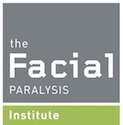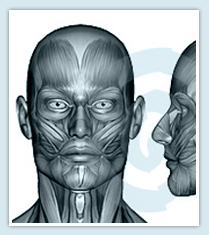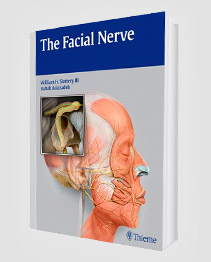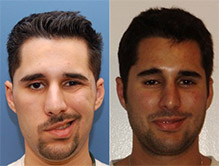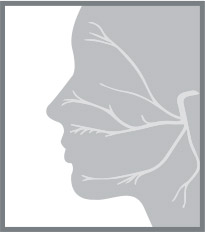Facial paralysis can result from trauma, infection, congenital, metabolic, neoplastic, toxic, iatrogenic, or idiopathic etiologies.
Whatever the cause, the consequences for the patient can be devastating depending on the level of facial dysfunction. Several modalities exist to clinically rate the degree of facial function; including the widely used House-Brackman classification.
WHAT IS THE HOUSE-BRACKMANN SCALE?
The House-Brackmann scale is a nerve grading system developed in 1985 by Los Angeles otolaryngologists Dr. John W. House and Dr. Derald E. Brackmann. It is used to characterize the severity of a facial paralysis patient’s symptoms.
House-Brackmann classification scores include the following:
- Grade I: Normal
- Grade II: Slight facial weakness or other mild dysfunction. Normal tone and symmetry at rest. Complete closure of the eye without effort. Slight asymmetry of the mouth when facial movements occur.
- Grade III: Assigned to patients dealing with moderate dysfunction; these patients generally do not display any noticeable facial weakness with synkinesis, they maintain complete eye closure and good forehead movement with effort.
- Grade IV: Assigned to patients dealing with severe dysfunction. Obvious facial weakness. Incomplete eye closure, no forehead movement, asymmetrical mouth movement, and synkinesis.
- Grade V: Assigned to patients who have little to no ability to smile, frown or make other facial expressions. The closure of the eye is incomplete, and there is no forehead movement.
- Grade VI: No facial motion.
A House-Brackmann score is determined based on a measurement of the upward movement of a facial paralysis patient’s eyebrow and the outward movement of the mouth. One point is assigned for every 0.25 cm of motion for both eyebrow and mouth movement, with a maximum of 1 cm. The scores are then added together, resulting in a House-Brackmann score.
The maximum House-Brackmann score is 8; in this instance, a facial paralysis patient’s eyebrow and mouth move 1 cm. All House-Brackmann classification scores are made based on eyebrow and mouth movement on the non-paralyzed side of a patient’s face.
What Is the Purpose of the House-Brackmann Scale for Facial Paralysis?
The House-Brackmann scale is one of many tools that can be used to evaluate the severity of a facial paralysis patient’s symptoms. Yet, using the scale on its own is insufficient.
Facial paralysis symptoms can vary in terms of severity. The House-Brackmann grading system can be used to evaluate these symptoms, but additional testing is usually required to assess their severity. Then, once a patient is fully evaluated, he or she can receive a custom treatment designed to deliver long-lasting symptomatic relief.
Is the House-Brackmann Grading System for Facial Palsy Accurate?
Some research indicates the House-Brackmann scale provides accurate measurements of the severity of a facial paralysis patient’s symptoms. However, it is important to note that the House-Brackmann classification offers only six grades. The House-Brackmann grading system also does not include a specific evaluation of synkinesis, and it does not allow physiotherapists to identify minor improvements in a facial paralysis patient’s symptoms during treatment.
Furthermore, the House-Brackmann scale does not account for the fact that facial paralysis symptoms may be more severe in certain parts of the face than others, too. For instance, if a patient experiences mild facial paralysis symptoms in one section of the face and severe symptoms in another portion, the patient may require separate House-Brackmann grades to account for symptoms on different parts of the face.
House-Brackmann Grading Scale Alternatives
The Burres-Finch system is a House-Brackmann grading scale alternative that was designed to minimize subjectivity. It involves the use of a continuous graded scale of linear measurements of different reference points across a facial paralysis patient’s face. These measurements were used to produce electromyographic recordings and provided objective insights into the severity of a patient’s facial paralysis symptoms.
Along with the Burres-Finch system, the Nottingham system has been used as a House-Brackmann scale alternative. Like the Burres-Finch system, the Nottingham system focused on providing an objective look at a patient’s facial paralysis symptoms. The Nottingham system also includes criteria designed to provide insights into secondary facial defects.
The Sunnybrook scale is another facial paralysis grading system used in lieu of or in conjunction with the House-Brackmann scale. With the Sunnybrook scale, a single score is generated that accounts for primary and secondary facial defects.
The Bottom Line on the House-Brackmann Scale for Bell’s Palsy
The House-Brackmann scale for Bell’s Palsy or other forms of facial paralysis can be used to measure the severity of a patient’s symptoms, but it offers no guarantees. Facial paralysis symptoms vary, and a patient requires an in-depth evaluation to determine why these symptoms are occurring and what can be done to correct them and prevent them from recurring. It is therefore crucial for a facial paralysis patient to meet with an expert facial paralysis and reconstructive surgeon, like Dr. Babak Azizzadeh of The Facial Paralysis Institute to discuss their symptoms.
During a first consultation with Dr. Azizzadeh, a facial paralysis patient will receive a full evaluation. Then, Dr. Azizzadeh offers a personalized treatment plan to help his patient address their facial paralysis symptoms.
The Facial Paralysis Institute is the preeminent Center for patients who require treatment for facial paralysis. If you live in Southern California, please contact us to arrange for an in-person consultation with Dr. Babak Azizzadeh, the Director of the Institute. If you are from out of the region, please email close-up photos (front, below the nose and profiles) to [email protected]. Virtual consultations with Dr. Azizzadeh are also available. For more information about facial paralysis treatment options, please call us at (310) 657-2203.
NERVE INJURY
Request your consultation with Dr. Azizzadeh today
Call us at (310) 657-2203 to schedule an appointment.
Schedule a Consultation